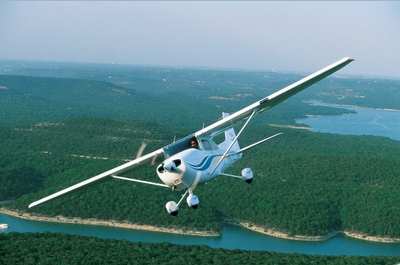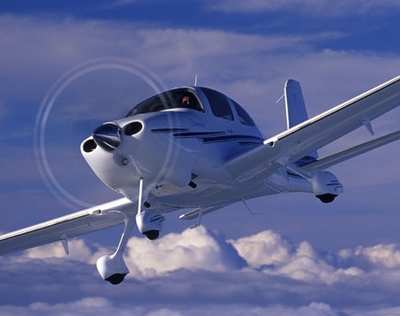Neither Pilot Saw The Other Aircraft
 A mid-air collision which occurred last August in Wyoming
happened because the pilots of the two aircraft involved simply did
not see each other, according to a probable cause report released
Tuesday by the NTSB.
A mid-air collision which occurred last August in Wyoming
happened because the pilots of the two aircraft involved simply did
not see each other, according to a probable cause report released
Tuesday by the NTSB.
NTSB Identification: LAX08FA265A, LAX08FA265B
14 CFR Part 91: General Aviation
Accident occurred Sunday, August 10, 2008 in Rock Springs, WY
Probable Cause Approval Date: 7/14/2009
Aircraft: CESSNA R172K, registration: N758NH, Cirrus Design Corp.
SR22, registration: N8341
Injuries: 3 Fatal.
The National Transportation Safety Board determines the probable
cause(s) of this accident as follows:
The failure of both pilots to see and avoid each other's
aircraft.
On August 10, 2008, about 1223 mountain daylight time, a Cessna
R172K, N758NH, and a Cirrus SR22, N8341, collided in midair about 5
nautical miles northwest of the Rock Springs-Sweetwater County
Airport (RKS), Rock Springs, Wyoming. Both airplanes were destroyed
by impact damage and fire. The student pilot, sole occupant of the
Cessna, and the private pilot and passenger in the Cirrus were
killed. The Cessna was registered to, and operated by, Franklin
Aviation, Rock Springs. The Cirrus was registered to Renard Argent,
Inc., Wilmington, Delaware, and operated by the pilot. Visual
meteorological conditions prevailed. Both airplanes were operating
under 14 Code of Federal Regulations Part 91. The Cessna departed
Rock Springs Airport about 1155 on a local solo instructional
flight for the purpose of practicing maneuvers; no flight plan was
filed. The Cirrus departed Polson, Montana, about 0955, on a
personal cross-country flight to Rock Springs; an IFR flight plan
was filed and activated.

File Photo
At 1219, the Cirrus pilot reported the airport in sight and was
cleared for the visual approach. The sector 5 radar controller
issued traffic advisories for numerous targets in the vicinity of
Rock Springs and approved a change to advisory frequency, advising
the pilot to cancel his IFR flight plan on his frequency or through
Flight Service. The pilot responded by stating, "all right 8341
will start a report over your frequency when I get the other
targets any idea what they are using there for runways?" At
1220:20, the controller stated that he did not know which runway
was in use, and issued the current surface wind report for Rock
Springs. The controller then issued another traffic advisory,
advisory stating, “right now I’m showing one target
it’s ah ah will be your eleven oclock your one oclock and ah
about one zero miles north ah well primarily eastbound east north
eastbound altitude indicates niner thousand five hundred." At
1220:47, the pilot responded, "8341 thank you." There was no
further contact with the Cirrus.
Radar data was provided by the FAA and was obtained from the
Rock Springs Air Route Surveillance Radar, located approximately 15
miles south of the airport. The data indicates that the Cessna was
maneuvering northwest of the Rock Springs Airport, and the Cirrus
was approaching the airport from the northwest while descending.
Between 1219:59 and 1220:28, the Cessna completed a 180 degree turn
from a southwesterly heading to a northeasterly heading. From
1220:27 to 1222:22, the Cessna maintained a northeasterly heading,
climbed from 9,300 to 9,800 feet msl, and leveled out. About
1222:22, the Cessna turned approximately 20 to 30 degrees right and
continued on that heading, level at 9,800 feet msl, until the last
radar return recorded at 1222:42. From 1220:27 to 1222:42, the
Cirrus descended from 11,300 to 9,700 feet msl on a heading of
about 130 degrees magnetic. The data depict the two airplanes
converging nearly perpendicular to one another. From 1220:50 to
1222:42, the Cirrus had an average ground speed of 195 knots and
was descending at an average rate of 740 feet per minute. The
Cessna had an average ground speed of 108 knots for the same time
frame. The data suggests the collision took place about 1222:52, at
an altitude of about 9,800 feet msl or about 3,300 feet above
ground level (agl). According to local authorities, several
witnesses reported seeing a cloud of smoke and flaming debris
falling to the ground.

File Photo
The Cessna pilot, age 54, held a third-class medical and student
pilot certificate that was issued on January 1, 2008. The
certificate was issued with the limitation: must have glasses
available for near vision. On the back of the certificate, there
were endorsements for solo flight in Cessna R172K airplanes and for
solo cross-country flight in airplanes dated April 10, 2008, and
May 1, 2008, respectively. Review of the Cessna pilot's logbook
revealed that he had accumulated 64.3 hours of total flight time of
which 11.6 hours were solo.
The Cirrus pilot, age 67, held a private pilot certificate with
single engine land and instrument airplane ratings. His most recent
first-class medical certificate was issued on April 25, 2007, with
the limitation: must wear corrective lenses. On January 2, 2008, he
completed a biennial flight review in the accident airplane.
Review of the Cirrus pilot's logbook revealed that he had
accumulated 1,434.8 hours of total flight time of which 1,316.4
hours were as pilot-in-command. The pilot had flown 671.3 hours in
Cirrus SR22 airplanes. He had flown 22 hours in the 30 days
preceding the accident.
 ANN's Daily Aero-Linx (04.16.24)
ANN's Daily Aero-Linx (04.16.24) Aero-News: Quote of the Day (04.16.24)
Aero-News: Quote of the Day (04.16.24) Airborne 04.10.24: SnF24!, A50 Heritage Reveal, HeliCycle!, Montaer MC-01
Airborne 04.10.24: SnF24!, A50 Heritage Reveal, HeliCycle!, Montaer MC-01 Airborne 04.12.24: SnF24!, G100UL Is Here, Holy Micro, Plane Tags
Airborne 04.12.24: SnF24!, G100UL Is Here, Holy Micro, Plane Tags Airborne-Flight Training 04.17.24: Feds Need Controllers, Spirit Delay, Redbird
Airborne-Flight Training 04.17.24: Feds Need Controllers, Spirit Delay, Redbird





